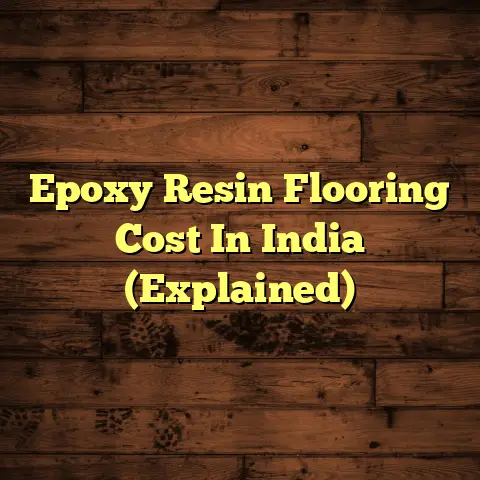Carpet With Dark Hardwood? (1 Style Disaster!)
Over the years, I’ve seen it all, from stunning transformations to… well, let’s just say some interesting design choices.
Today, we’re diving into a topic that’s near and dear to my heart (and my business!): flooring.
Specifically, the potential style disaster that can occur when you pair carpet with dark hardwood. Trust me, I’ve seen it!
Introduction: The Heart of the Home
Think about your living room, your family room, that one space where everyone gathers. It’s the backdrop for so many memories.
Family gatherings, game nights, cozy movie marathons – it’s where life happens. It’s the heart of your home.
The colors, textures, and materials in that space? They impact everything, from the mood to how functional the room is.
A well-designed family space can feel warm, inviting, and foster connection. A poorly designed one?
Well, it can feel…off. And that’s what we’re trying to avoid.
Section 1: The Allure of Dark Hardwood Flooring
Let’s talk about dark hardwood. It’s elegant, sophisticated, and oh-so-popular right now. And for good reason!
Dark hardwood floors exude a sense of luxury. They’re durable, relatively easy to clean (though dust does show!), and timeless.
Think espresso, walnut, ebony. Each style brings a unique charm, adding richness and depth to a room.
I’ve seen dark hardwood elevate countless spaces, creating a warm and inviting atmosphere. It’s a real showstopper.
According to the National Wood Flooring Association (NWFA), dark wood floors can increase a home’s value by up to 5%.
Section 2: The Rise of Carpet in Family Homes
Now, let’s shift gears to carpet. Why do so many families still choose carpeted areas, especially in family rooms?
Comfort, warmth, and sound absorption are the big reasons. There’s nothing quite like sinking your toes into a plush carpet.
Plus, carpet can add a splash of color, texture, and coziness. It can transform a cold, sterile room into a warm haven.
We’ve got plush carpets, Berber carpets, frieze carpets… the options are endless, each with its own unique benefits.
A study by the Carpet and Rug Institute (CRI) found that carpet can reduce airborne allergens by trapping them until vacuumed.
Section 3: The Clash of Styles: Dark Hardwood Meets Carpet
Here’s where things get tricky. Dark hardwood is gorgeous. Carpet is comforting. But together? It can be a style clash.
While both elements are beautiful on their own, their combination can sometimes create visual discord.
Think about it: the sleek, modern lines of dark hardwood juxtaposed against a shag carpet in a questionable color.
The contrast in texture, color, and design ethos can be jarring. It can detract from the overall harmony of a family space.
I’ve seen it happen, and it’s not pretty. It’s like wearing stripes and polka dots – both fun, but not together!
Section 4: Common Carpeting Mistakes with Dark Hardwood
So, where do families go wrong? What are the common carpeting mistakes I see when dark hardwood is involved?
Let’s break it down:
-
Color Clashes: A carpet that’s too bright or too light can clash with the deep tones of dark hardwood.
Think neon green against espresso. Ouch! It creates a jarring visual experience that’s hard to ignore.
-
Texture Conflicts: Different textures can compete.
A super-shaggy carpet next to sleek, polished hardwood? It can look messy and unbalanced.
The eye doesn’t know where to focus, and the overall effect is just…unpleasant.
-
Overwhelming Patterns: Overly busy carpet patterns can create visual chaos, especially against a dark floor.
Imagine a dark walnut floor paired with a carpet featuring a floral pattern in every color of the rainbow. Overwhelming!
It’s too much visual information, and it makes the room feel smaller and more cluttered.
-
Scale Issues: A tiny area rug floating in a sea of dark hardwood can look awkward and out of place.
The rug should be proportionate to the space and the furniture around it, otherwise it will feel off.
-
Ignoring Undertones: Dark hardwood comes in various undertones (warm, cool, neutral). The carpet should complement, not clash with, these undertones.
For example, a cool-toned gray carpet might look strange against a warm, reddish-brown hardwood.
Section 5: A Case Study of Style Disaster
Let me tell you about the Millers (not their real name, of course).
They were so excited to decorate their new home. They loved the idea of dark hardwood in the living room – so chic!
They also wanted a cozy carpet for the kids to play on. They envisioned family movie nights and building forts.
They chose a light beige, plush carpet. It felt amazing underfoot, but against the dark espresso hardwood, it looked…wrong.
The contrast was too stark. The light carpet made the dark floor look even darker, creating a cave-like atmosphere.
The Millers told me they felt a sense of unease every time they walked into the room. It just didn’t feel right.
The kids complained that the carpet showed every little crumb and stain (light carpet, remember?). Stressful!
The Millers eventually realized their vision hadn’t translated well. They felt frustrated and disappointed.
They ended up replacing the carpet with a darker, more muted option that complemented the hardwood.
The difference was night and day. The room felt balanced, inviting, and harmonious. The Millers were finally happy.
Section 6: The Ripple Effect on Family Dynamics
You might be thinking, “It’s just flooring! How much can it matter?”
But aesthetic choices can affect family dynamics more than you think.
A visually discordant environment can lead to feelings of discomfort or frustration among family members.
Imagine a family arguing over the “ugly carpet” or feeling stressed every time they walk into a mismatched room.
I’ve heard comments like:
“I hate spending time in the living room. It just doesn’t feel cozy.”
“The carpet is always dirty! It’s so stressful to keep clean.”
“I wish we had chosen something different. It just doesn’t feel like ‘us’.”
Creating a cohesive and inviting atmosphere is crucial for fostering family connections and overall well-being.
A well-designed space can promote relaxation, communication, and a sense of belonging. It’s an investment in your family’s happiness.
Section 7: Conclusion: The Lasting Impact of Design Choices
So, what’s the takeaway? Design choices have a lasting impact.
Style disasters like the carpet-dark hardwood combination can be disheartening, but they’re also learning experiences.
They teach us the importance of thoughtful planning, understanding color theory, and considering the overall aesthetic.
Ultimately, a home is defined by the love and memories shared within its walls, regardless of its design challenges.
But thoughtful design choices contribute not only to the aesthetic appeal of a home but also to the emotional well-being of its inhabitants.
So, take your time, do your research, and don’t be afraid to ask for help from a professional. Your family (and your sanity!) will thank you.





